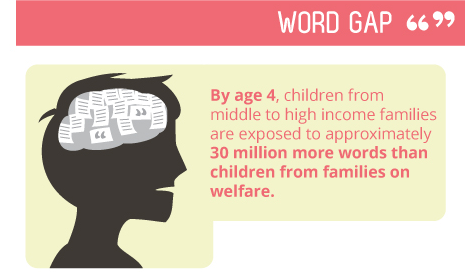Close the Word Gap and Build Stronger Brains with Language Nutrition
Differences in the size of a child’s vocabulary first appear at 18 months—and are correlated with education and income. Dana Suskind, author of the book “Thirty Million Words: Building a Child’s Brain,” offers a more comprehensive look at the word gap and what it means for student success.
Words and interactions are incredibly valuable to the rapidly developing brain of an infant. They’re so valuable that some early literacy initiatives have begun calling it “language nutrition.”
3 Implications for Our Kids and Community
- Interactions are key in the first few years of a child’s life. According to Harvard University’s Center of the Developing Child, parents can positively influence their children’s brain development through “serve and return interactions.” This means that when an infant or child cries, babbles, or gestures, the adult responds with eye contact, words, and touching. These interactions help build neural connections that support the child’s communication and social skills. Check out this video to see more on serve and return.
- Frequent, positive interactions and words matter. Higher income parents spend almost a half-hour more daily talking, interacting, or reading with their children than low-income parents. It’s not just the amount of words, it’s the type too. Positive, affirmative phrases (“please walk” versus prohibitive phrases such as “don’t run”) also have an impact on the child’s language development and a child’s stress level.
- The word gap matters for student academic and lifetime success. For many low-income early learners who get less face-to-face interaction (reading and speaking together), that means a higher probability of being less successful in grade school, dropping out of high school, and earning less income. To combat this, researchers are calling for programs that start earlier and that equip parents with what they need to bridge the word gap. One program called Starling is trying to do just that by partnering with nonprofits, government, daycares, schools, and other community organization to promote a device that counts words so parents and caregivers can track how much they are talking to their child. And home visiting programs, such as Nurse Family Partnership and Parents as Teachers, help families learn and practice skills to build their children’s brains.
Take Action
- Share QT30 (Quality Time 30 Minutes) with families with young children. Delaware Thrives promotes “serve and return” among parents through age appropriate activities that encourage early childhood development.
- Volunteer with Read Aloud Delaware to help build literacy in young children.
- Check out Parents as Teachers. Parents as Teachers programs happen across the state. The Christina Early Education Center is one example of this free early learning resource that provides parents with information on child development and activities that help build your child’s cognitive and motor skills.
Check-out the Rodel website to learn more about Delaware education policy issues from Early Learning to college and career readiness.
